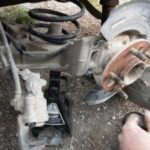The CV (constant velocity) axles are crucial parts of your vehicle’s drivetrain, responsible for transmitting power to the wheels. These axles allow your car to navigate turns and bumps smoothly. However, due to their exposure to harsh conditions, CV axles and their joints can wear out over time, eventually requiring repair or replacement. If you’re wondering about the time commitment for this essential repair, let’s delve into how long it takes to repair a car axle.
Understanding CV Axle Repair Timeframes
The duration of a car axle repair isn’t fixed; it varies depending on several factors. While a straightforward replacement might be relatively quick, more complex situations can extend the time your vehicle spends in the shop. Key factors influencing the repair timeline include:
- Vehicle Make and Model: Different vehicles have varying axle designs and accessibility. Working on some models might be more intricate than others, affecting the labor time.
- Axle Location (Front vs. Rear): Whether you need a front or rear axle repaired can influence the time. Front-wheel drive vehicles often have more complex front axle setups compared to rear-wheel drive cars.
- Severity of Damage: If only the CV joint boot is torn, a simple boot replacement might be possible, saving time compared to a full axle assembly replacement. However, if the joint itself is damaged, a complete axle replacement is usually necessary, taking longer.
- Number of Axles Requiring Repair: Replacing multiple axles will naturally take longer than addressing a single one.
- Shop Availability and Workload: The repair time can also be affected by the service center’s schedule. A busy shop might have a longer turnaround time than one with immediate availability.
Typical CV Axle Repair Process
To understand the time involved, it’s helpful to know the general steps of a CV axle repair:
- Diagnosis: The first step involves identifying if the issue is indeed with the CV axle. Mechanics will inspect for signs like clicking noises during turns, vibrations, or visible damage to the CV joint boots.
- Vehicle Preparation: The car is safely lifted, and the wheel(s) on the affected side are removed to access the axle assembly.
- Disassembly and Removal: Components like the brake caliper, rotor, and suspension parts may need to be removed to gain clear access to the CV axle. The axle is then carefully detached from the wheel hub and transmission or differential.
- Axle Replacement or Rebuild: Depending on the damage and cost-effectiveness, the entire axle assembly is replaced with a new or remanufactured unit. In some cases, if only the CV joints are worn, a rebuild might be possible, though full replacement is more common for efficiency and long-term reliability.
- Installation: The new or rebuilt axle is installed, and all removed components (brakes, suspension parts, wheel) are reassembled and properly torqued.
- Testing and Inspection: After the repair, the vehicle is test-driven to ensure the issue is resolved and the new axle is functioning correctly. Mechanics will also re-inspect for any leaks or abnormalities.
Average Time for CV Axle Repair
For a standard CV axle replacement on a typical passenger car, you can generally expect the labor to take approximately 1.5 to 3 hours per axle. This timeframe covers the removal of the old axle, installation of the new one, and basic testing.
Keep in mind that this is an average range. Simpler repairs on easily accessible axles might be closer to the 1.5-hour mark, while more complex jobs, especially on larger vehicles or those with rusted components, could approach or slightly exceed 3 hours per axle.
If you require multiple axle replacements, the labor time will increase accordingly. For example, replacing two front axles might take between 3 to 6 hours, and if you have an all-wheel-drive vehicle needing all four axles replaced, the service could potentially extend to 12 hours or more, as mentioned in the original article in the context of labor costs.
Factors That Can Extend Repair Time
While the 1.5 to 3-hour estimate is typical, several unforeseen issues can prolong the repair process:
- Rust and Corrosion: In regions with harsh winters or road salt use, rust can seize bolts and components, making disassembly difficult and time-consuming.
- Damaged or Stripped Fasteners: During removal, bolts or nuts might break or strip, requiring extra time to extract or repair the damaged threads.
- Related Component Damage: Sometimes, a failing CV axle can cause damage to surrounding components, such as wheel bearings or suspension parts, which may need to be addressed simultaneously, adding to the overall repair time.
- Parts Availability: In rare cases, if the specific axle for your vehicle is not readily available, there might be a delay in obtaining the necessary part, extending the total repair duration.
Why Professional Repair is Recommended
While some car owners might consider DIY CV axle replacement, it’s generally recommended to entrust this repair to qualified professionals. Replacing a CV axle involves:
- Specialized Tools: Proper axle removal and installation often require specific tools like axle pullers, torque wrenches, and sometimes specialized sockets.
- Mechanical Expertise: Understanding the vehicle’s suspension and drivetrain system is crucial for safe and correct axle replacement. Improper installation can lead to further damage or safety issues.
- Safety Considerations: Working under a vehicle and handling suspension components requires safety precautions and knowledge to avoid injury.
Professional technicians at reputable service centers like Becker Service Center possess the expertise, tools, and experience to efficiently and correctly diagnose and repair your CV axles. This ensures the job is done right, minimizing potential delays and ensuring your vehicle’s safe operation.
Conclusion
The question “how long does it take to repair a car axle?” typically translates to a repair window of 1.5 to 3 hours per axle for most common vehicles and straightforward replacements. However, various factors can influence this timeframe. For an accurate estimate tailored to your specific vehicle and situation, it’s always best to consult with a qualified mechanic. Scheduling an appointment with a trusted repair shop will provide you with a precise diagnosis, repair timeline, and get you back on the road with confidence.


